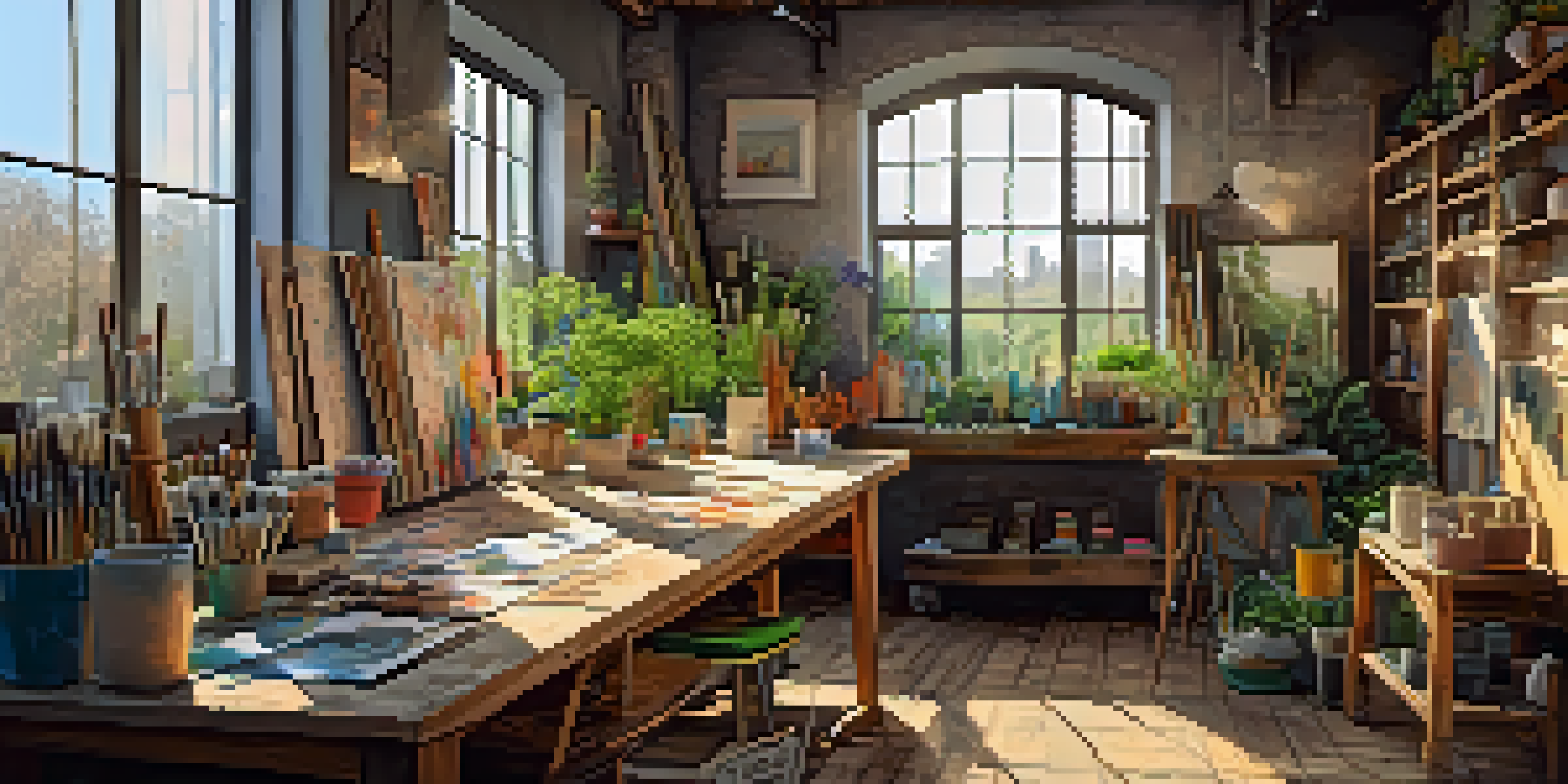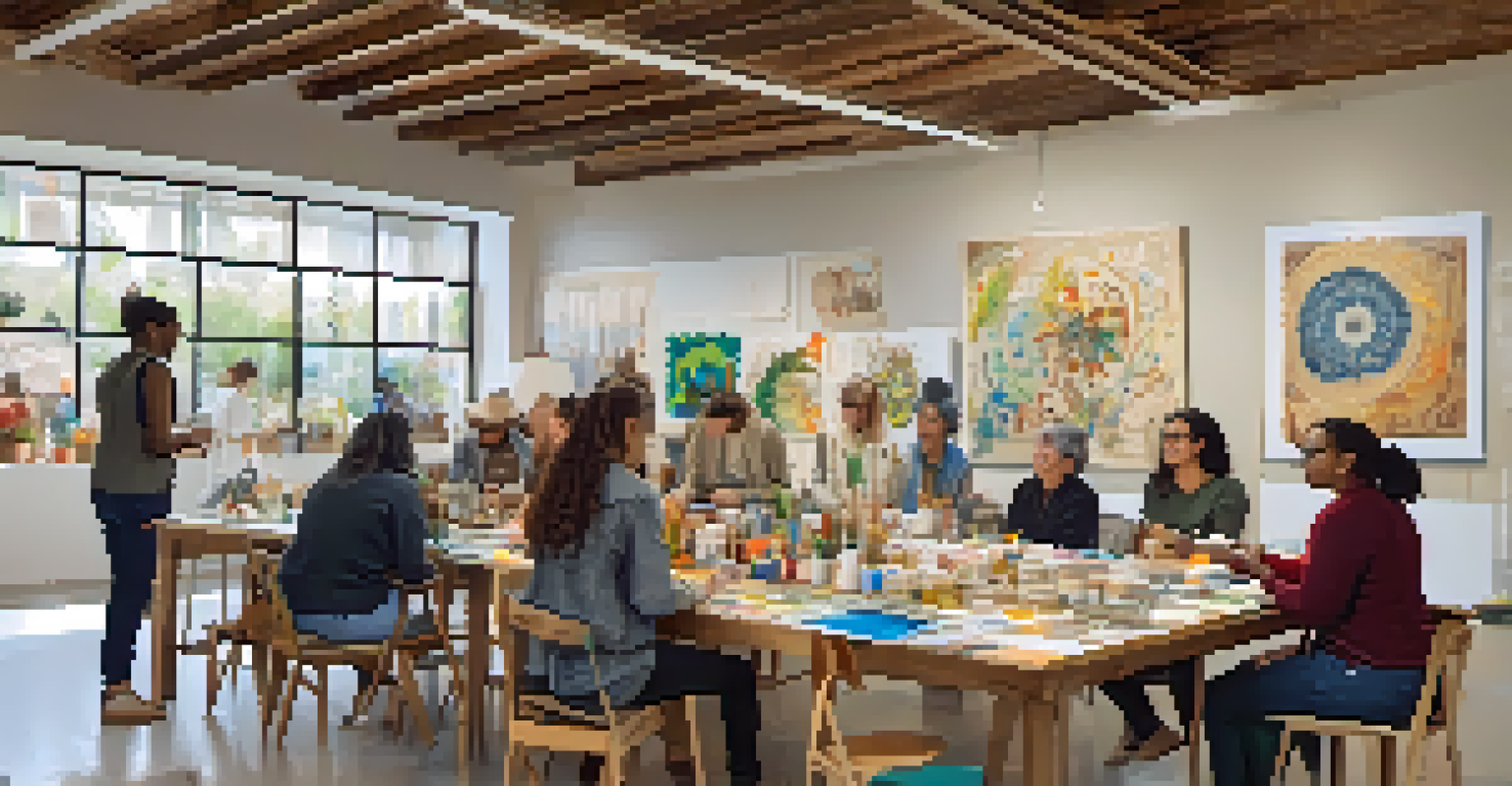Sustainable Practices in Contemporary Painting Techniques

Understanding Sustainability in the Art World
Sustainability in art refers to practices that minimize environmental impact. Artists are increasingly aware of their ecological footprint and are seeking ways to create without harming the planet. This shift not only enhances the artistic practice but also resonates with audiences who value environmental responsibility.
Art is not a mirror held up to reality, but a hammer with which to shape it.
By using sustainable materials and methods, artists contribute to a larger movement toward a greener planet. This can include sourcing locally, using non-toxic paints, or opting for recycled materials. The connection between art and nature is becoming more pronounced, inviting artists to engage with their environments thoughtfully.
As the conversation around climate change grows louder, artists have a unique opportunity to lead by example. By integrating sustainability into their work, they inspire others to consider the environmental ramifications of their choices, both in art and beyond.
Eco-Friendly Materials: A New Palette for Artists
The choice of materials is crucial in sustainable painting. Traditional paints often contain harmful chemicals, but many eco-friendly alternatives have emerged. These paints, made from natural ingredients, are safer for both artists and the environment, providing a vibrant palette without the toxic side effects.

Recycled and upcycled materials are also gaining popularity among contemporary painters. From using reclaimed wood for canvases to crafting brushes from repurposed items, artists are finding creative ways to reduce waste. This practice not only promotes sustainability but also adds a unique character to each artwork.
Art and Sustainability Unite
Artists are increasingly adopting eco-friendly practices and materials to minimize their environmental impact.
Moreover, some artists are experimenting with plant-based pigments, which are not only biodegradable but also rich in color. This return to natural sources aligns with the growing trend of embracing traditional techniques while ensuring modern practices remain environmentally conscious.
Innovative Techniques: Redefining Painting Processes
Sustainable painting techniques often embrace innovation, making art creation more environmentally friendly. For instance, water-based paints are gaining traction due to their lower environmental impact compared to oil-based options. These paints not only reduce harmful emissions but also clean up easily with soap and water.
The greatest threat to our planet is the belief that someone else will save it.
Another technique gaining ground is the use of digital tools alongside traditional methods. Digital painting allows artists to create without physical materials, drastically reducing waste. This hybrid approach offers a modern twist while still allowing for the tactile engagement that many artists cherish.
Additionally, some painters are exploring natural adhesives and varnishes derived from plants. These alternatives not only preserve the integrity of the artwork but also ensure that the final product is safe for the environment. By embracing these innovative practices, artists are paving the way for a sustainable future.
The Role of Community in Sustainable Art Practices
Community plays a vital role in promoting sustainable practices within the art world. Local art collectives and organizations often encourage artists to share resources and knowledge about eco-friendly methods. This collaborative spirit fosters innovation and helps artists feel supported in their sustainable endeavors.
Workshops and community events focused on sustainable art techniques are becoming more prevalent. These gatherings not only educate artists about eco-friendly options but also connect them with like-minded individuals who share a passion for sustainability. This sense of community amplifies the impact of individual efforts, creating a larger movement.
Community Drives Sustainable Art
Local art collectives and workshops foster collaboration and knowledge sharing, enhancing sustainable practices among artists.
As artists come together to share their experiences, they can inspire one another to push boundaries and experiment with new techniques. This collaborative approach helps to cultivate a culture of sustainability that extends beyond individual practices, influencing the broader art community.
The Impact of Sustainability on Art Market Trends
The art market is evolving, with sustainability emerging as a key trend among collectors and buyers. Many art enthusiasts are increasingly inclined to support artists who prioritize eco-friendly practices. This shift reflects a growing awareness of environmental issues and a desire to invest in art that aligns with personal values.
Moreover, galleries and institutions are beginning to highlight sustainable art practices, providing a platform for eco-conscious artists. Exhibitions focused on sustainability attract attention and encourage dialogue about the importance of environmental responsibility in art. This visibility can significantly boost an artist's career while promoting eco-friendly initiatives.
As more artists adopt sustainable practices, the conversation around art and the environment will continue to gain momentum. This trend not only benefits artists but also educates the public about the importance of sustainability, paving the way for a more conscientious art market.
Challenges in Adopting Sustainable Painting Techniques
While the movement toward sustainable painting practices is promising, it does come with its challenges. For many artists, the initial cost of eco-friendly materials can be higher than traditional options, making it a barrier to entry. However, as demand for sustainable products grows, prices are likely to decrease, making them more accessible.
Additionally, some artists may struggle to find reliable sources for sustainable materials. The market for eco-friendly options is still developing, and not all regions have access to these resources. This lack of availability can hinder artists who are eager to adopt sustainable practices but are limited by their local options.
Market Trends Favor Eco-Friendly Art
Collectors are showing a growing preference for art that aligns with sustainable values, influencing the art market significantly.
Despite these challenges, the benefits of sustainable painting techniques often outweigh the obstacles. As artists continue to advocate for eco-friendly practices, the art community is likely to rally together to address these issues, paving the way for a more sustainable future.
Future Directions: The Evolution of Sustainable Art
The future of sustainable practices in painting is bright, with ongoing innovation and collaboration on the horizon. As artists push the boundaries of creativity, we can expect to see more groundbreaking techniques that prioritize environmental responsibility. This evolution will likely inspire new generations of artists to embrace sustainability in their work.
The integration of technology into art is also set to play a significant role. As digital tools become more advanced, artists will have even greater opportunities to create sustainably. This intersection of technology and art could lead to exciting new forms of expression that challenge traditional notions of painting.

Ultimately, the journey toward sustainable practices in contemporary painting is an ongoing one, filled with potential and promise. By embracing innovation, community, and education, artists can transform the art world into a more sustainable and environmentally conscious space that resonates with audiences for years to come.